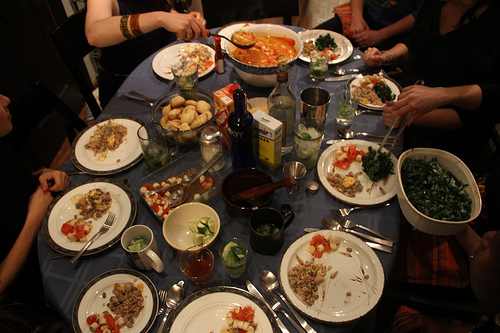 Brazil is a hugely diverse country both geographically and demographically. Well, first, it's just huge, ranking #5 for both land area and population. The geography spans from the depths of the Amazon jungle to tropical shores (over 4,500 miles' worth!) to temperate cattle-grazing lands. Its people come from all over, and of course brought their foods with them: Africans brought palm oil and okra, Europeans contributed pastry and cattle, the local lands provide manioc and all manner of fruit. (Also, did you know that São Paulo has the largest Japanese population of any city outside of Japan?) To that end, I did my best to choose a menu incorporating this diversity.
Brazil is a hugely diverse country both geographically and demographically. Well, first, it's just huge, ranking #5 for both land area and population. The geography spans from the depths of the Amazon jungle to tropical shores (over 4,500 miles' worth!) to temperate cattle-grazing lands. Its people come from all over, and of course brought their foods with them: Africans brought palm oil and okra, Europeans contributed pastry and cattle, the local lands provide manioc and all manner of fruit. (Also, did you know that São Paulo has the largest Japanese population of any city outside of Japan?) To that end, I did my best to choose a menu incorporating this diversity.
To bring a flavor of the tropics to this cold February weekend, I trundled up to Astoria again, where the Rio Supermarket had every last Brazilian specialty item on my shopping list. At the buffet here, rather than at home, is where I enjoyed feijoada — while it is the favorite for being Brazil's national dish, it didn't fit with my regional-specialties ambition. It wasn't until I was done shopping that I realized this is an entirely gluten-free menu: celiacs take note! Manioc/cassava/tapioca is your friend.
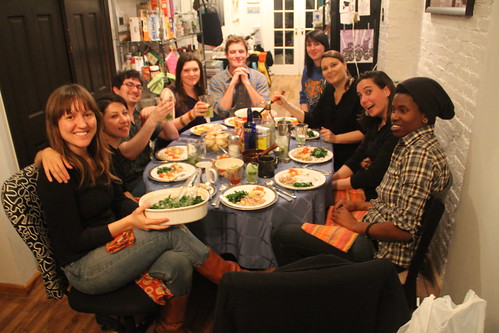
We had quite the media-inclined group around the table. From Laura's MFA IMA program were Cassie (with friend Marian), Nathan (with friend Sophia) and Esy; Andi from UN News and Media, Lisa, and Sophie. Cassie spent a year as a high schooler in Brazil and regaled us with tales, especially of some of the courtship rituals around Carnaval; Lisa has some Brazilian family too.
Caipirinhas and caipiroshkas
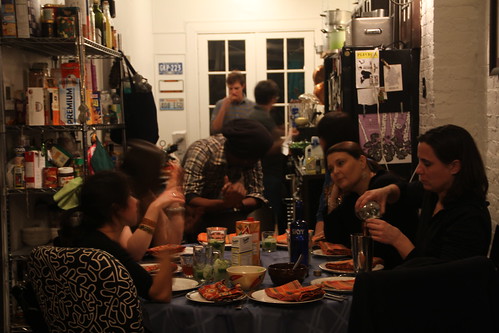
Lisa came prepared to tend bar, with a sack of limes and all the necessary equipment to make the classic Brazilian cocktail of cachaça, sugar, and muddled lime. (Cachaça is pronounced kuh-SHAW-suh; while rum is made from molasses, cachaça comes from pure sugar cane juice.) "Caipirinha" apparently is the diminutive of the word for "hillbilly." We also had caipiroshkas, the same drink made from vodka. Thank you Lisa!
Some of us also poured in cashew juice, made from the fruit from which the cashew nut emerges. (Pictures are crazy!) It's a lovely flavor, surprised it hasn't caught on here.
Pão de queijo | Cheese breads | Recipe
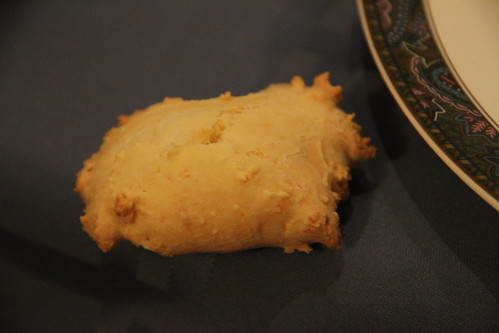
These must be extremely popular in Brazil if only judging from how many different types of mixes and frozen packages I saw in the store. Also, as you'll see on the recipe, some serious study has been applied to the chemical interaction between the ingredients. These pão deserve the love and attention since they're pretty great: a bit crispy on the outside, soft on the inside, cheesy and salty, a consummate snack.
When making them I think I messed up by putting in too much milk, so if you're inclined to make them, please follow the metric weights on the recipe and not the vaguely estimated volume equivalents. I used up all my manioc flour, so I put in some soft wheat flour to make up the difference (left over from Bosnia!). I still couldn't manage to roll it by hand, so I treated them like drop cookies, leading to some silly shapes such as above. But no matter: they tasted great.
Couve refogada | Sautéed collard greens | Recipe
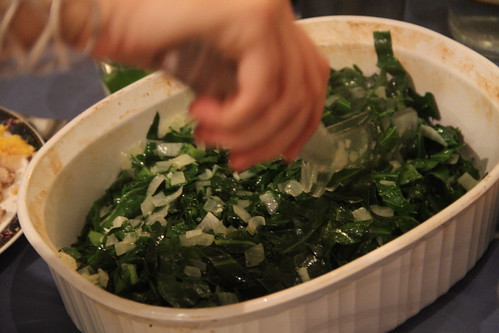
Southern US cuisine cooks its collards nice and slow, with fat and salt, for up to a few hours until the big leaves turn pale and soften up. The Brazilians do just about the opposite: cut into a chiffonade, sautéed for just a few minutes on high heat, preserving their texture and color. Apparently this is such a common approach that you can buy your collards pre-cut in your typical grocery in Brazil.
Moqueca | Fish stew | Recipe
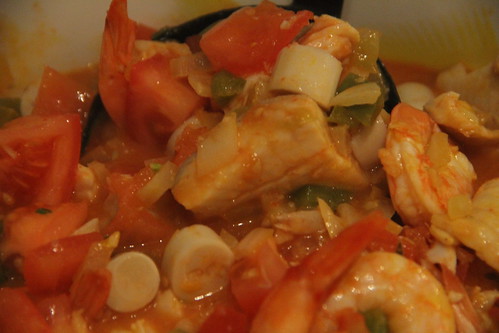
Bahia, in the northeast, would snuggle up against Angola if Africa and South America were smushed back together (see?). And it was when we cooked Angolan food that we first encountered the richly flavored and, uh, gut-lubricating red palm oil. This Bahian fish stew features some of this oil, known as aceite de dendê, but in much more moderate quantities. With an hours-long marinade, tilapia and shrimp, coconut milk and more, I expected that this would be richly flavored and tasty, but while it was totally fine to eat it wasn't a knockout. Maybe it'd be better if I'd made my own fish stock or found more exciting fish than tilapia — so keep this in mind if you plan to make it.
Feijão tropeiro | Cattleman's beans | Recipe
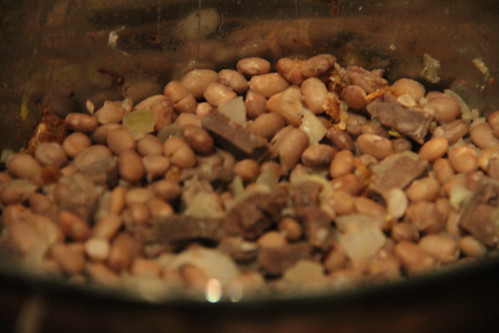
One could say that feijão tropeiro is to the Brazilian cerrado what chile con carne is to the American southwest: a staple of settlers traversing an unreliable land that's now a comfort food with infinite variations. This recipe is from Minas Gerais, the state that occupies a France-sized swathe of the interior north of São Paulo and Rio. My one variation from the recipe is that instead of the fried pork rind, I substituted dried beef since that's what they had at the store. I also used carioca beans, which I just learned were specifically developed in Brazil for high yield and nutrition. (They also taste quite good!) Sprinkled with toasted manioc for texture and starch, this makes for a substantial core of a meal, and I was happy to see a few guests eagerly take home the leftovers.
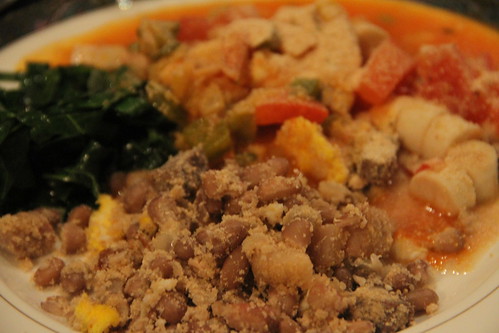
Sorvete de graviola | Soursop frozen yogurt | Recipe
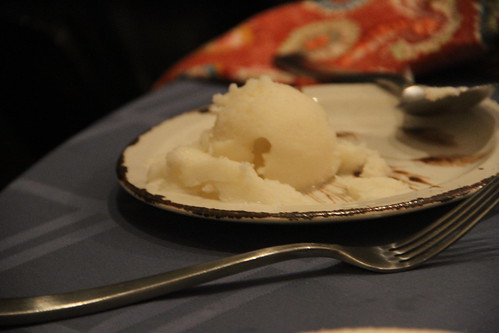
Brazil has a wide variety of fruits that either have no translation into English (see below) or have English names that sound so weird I wonder why we have one. Soursop just sounds really unappealing. But get past the name, and it's pretty tasty, definitely tangy, with a bit of a bready texture. I ended up making this sorvete with nonfat yogurt, since it's the only non-flavored, non-Greek yogurt I could find at the two markets around the corner. (The challenges of a yuppie neighborhood!)
Pudim de cupuaçu | Cupuaçu flan | Recipe
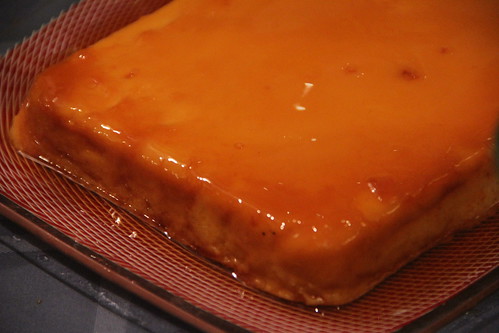
If only this flan tasted as good as it looks! The caramel was fine, and also insanely tedious, taking about 40 minutes of careful stirring. The texture was marvelous. But despite my hopes and expectations for cooking with this close relative of cacao, it just tasted weird and not in a good way. Good thing I made two desserts!
All in all, I was a bit disappointed in Brazilian food. Maybe it was my technique, but the only dish that I knowingly messed up turned out really nicely anyway. But the company was fantastic, we shared plenty of stories and laughs.
Next week we're taking off, and after that we're heading over to Brunei Darussalam for a very different angle on what tropical cooking can be!